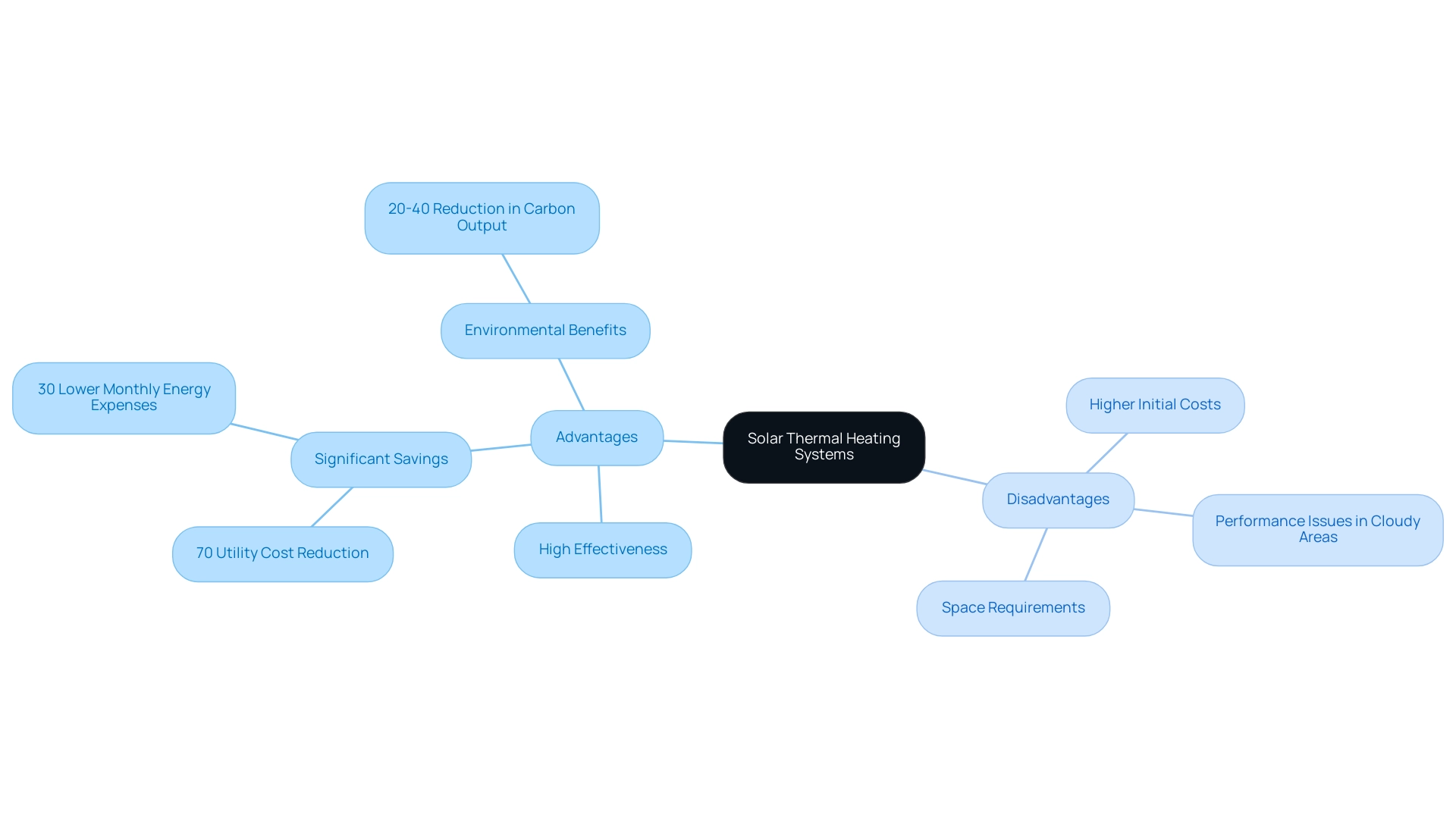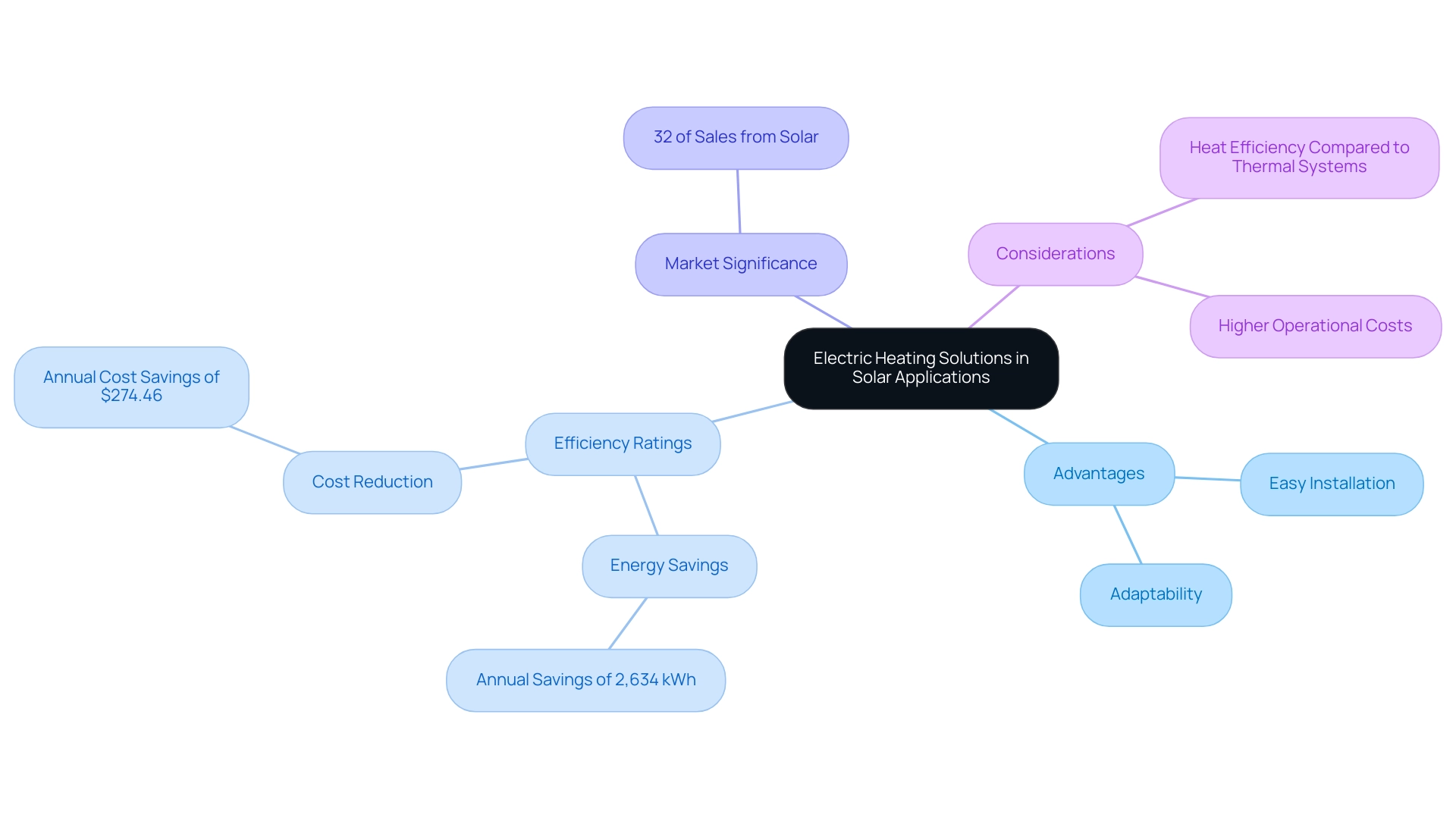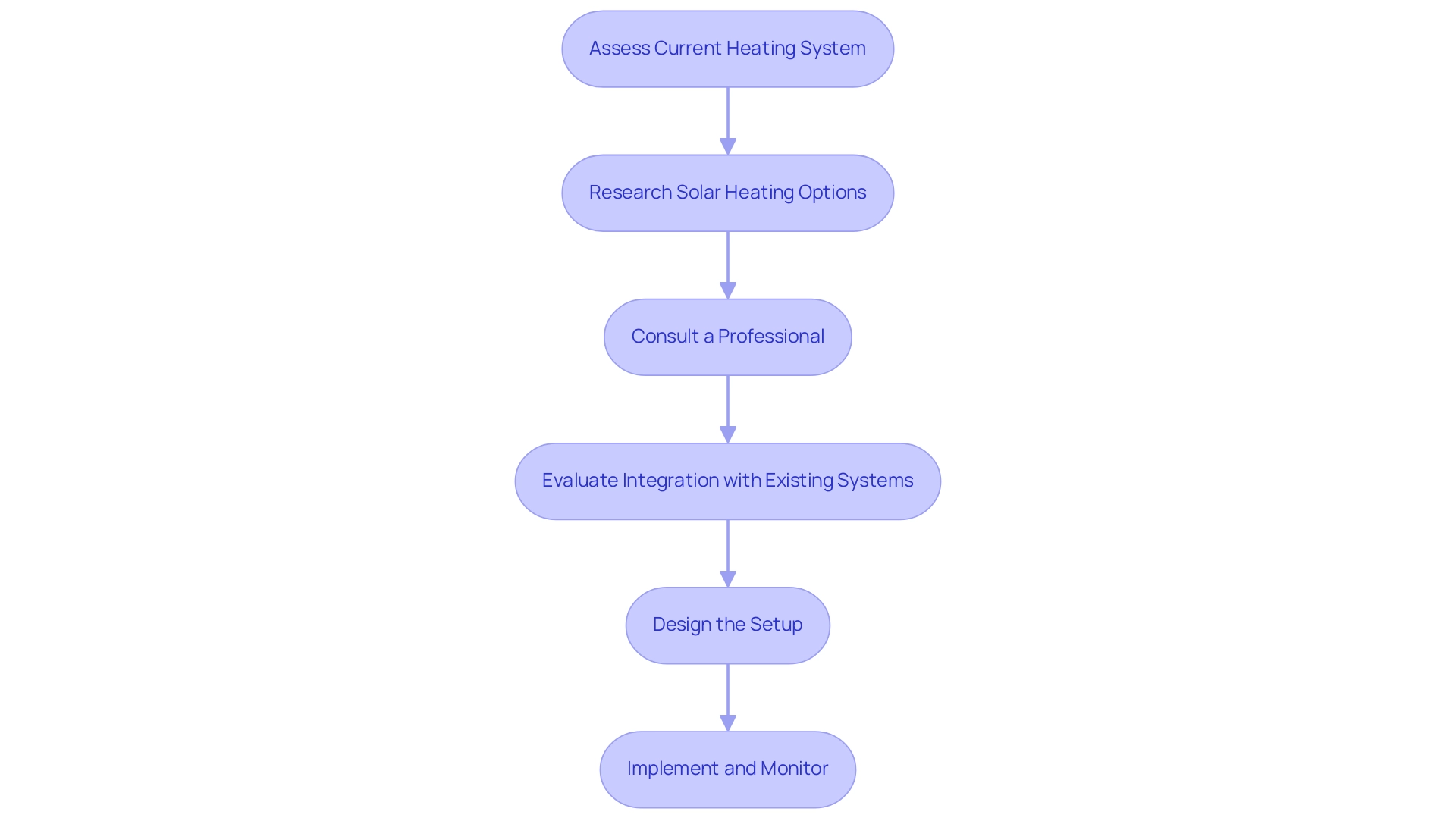Introduction
Deciding how to heat a home can feel overwhelming, especially with so many options available today. Homeowners are increasingly drawn to sustainable solutions, and two popular contenders are solar thermal and electric heating systems. Both offer unique benefits and challenges, making it essential to understand their differences and how they can impact energy efficiency and costs.
From harnessing the sun’s warmth to innovative electric solutions that adapt to existing setups, this article dives deep into the world of heating technologies. With insights on economic considerations, integration strategies, and the latest advancements, readers will be equipped to make informed choices that not only enhance comfort but also contribute to a greener future.
Understanding Solar Thermal and Electric Heating Solutions
Heating solar solutions function like a cozy blanket for your home, capturing sunlight to produce warmth that heats water or air for your daily comfort. These setups typically comprise solar collectors that capture sunlight and a storage tank that holds the heated water for use. Imagine immersing yourself in a warm bath with water warmed directly by the sun—not only is it environmentally friendly, but it’s also a wonderful method to lower utility costs!
In contrast, electric warming solutions function differently. These setups depend on electricity to produce warmth through techniques such as electric resistance and heat pumps. While both thermal systems and electric heaters can harness sunlight, their operational mechanisms differ greatly, affecting their efficiency in different climates and household requirements.
Recent advancements, particularly with perovskite cells, have opened new avenues for enhancing warmth efficiency. For Palo Alto homeowners, this technology offers enhanced power solutions customized to local circumstances, potentially boosting the share of sunlight-based power in home heating. According to Lucía Fernández, in 2022, photovoltaic energy represented only 5.4% of renewable heat consumption globally, lagging behind bioenergy and heat pumps.
This statistic highlights the growth potential for thermal technologies, especially as we approach a forecasted thermal heat consumption of 2,457.5 petajoules by 2030. Such a significant forecast emphasizes the growing acknowledgment of thermal technologies, including heating solar, as a feasible choice for sustainable home heating. Furthermore, it’s crucial to comprehend the financial benefits of heating solar solutions.
They can lead to significant reductions in utility bills, making them a cost-effective choice in the long run. Furthermore, thermal technologies can be classified into active and passive types:
- Active setups utilize mechanical devices to circulate fluids.
- Passive approaches depend on building design and materials to naturally collect and store heat.
Recent policy recommendations for thermal technologies emphasize the need for harmonizing regulations and developing zero-carbon-ready building codes. These advancements could enable the implementation of thermal technologies, encouraging both ecological sustainability and job creation in this field.
Ultimately, selecting between thermal and electric solutions will rely on your home’s particular needs and your dedication to sustainability. By understanding the key differences, the impact of innovative technologies like perovskite cells, and considering the growth trajectory of heating solar technologies, you can make an informed decision that aligns with your lifestyle and contributes to a greener planet. Embrace the advantages of solar warmers today and reach out to Powercore Electric Inc. to explore your choices for sustainable power solutions!
Pros and Cons of Solar Thermal Heating Systems
Heating solar technologies offer numerous advantages, primarily their exceptional effectiveness in transforming sunlight into warmth. Numerous case studies emphasize how these frameworks can result in remarkable savings, particularly for environmentally aware homeowners in sunny regions. For instance, a household in Southern California reduced their utility costs by over 70% after installing a heating solar water system, complemented by a heat exchanger.
Imagine having consistent hot water for your home, powered by heating solar energy from the sun itself! In cooler areas, passive designs, such as large south-facing windows, have also demonstrated significant effectiveness in retaining heat during winter months. According to Clean Energy Resource Teams, heating solar-powered air heaters can decrease a household’s carbon output by 20 to 40 percent and lower monthly energy expenses by 30 percent.
However, it’s essential to consider some potential drawbacks. The initial installation expenses may be higher in comparison to electric systems, and sufficient area for collectors is required. Additionally, those living in areas that experience frequent cloudy or rainy days may find a dip in performance.
As Monika Spoerk-Duer observes, ‘With data from 68 nations, it is the most extensive assessment of thermal energy and cooling markets globally.’ Additionally, examining governmental initiatives aimed at promoting renewable power adoption can offer extra financial benefits for homeowners. Balancing these factors, along with insights into relevant renewable energy solutions such as Tesla home chargers, can help you determine if this heating solar solution is the right fit for your home.
Evaluating Electric Heating Solutions in Solar Applications
Electric warmth solutions are often celebrated for their straightforward installation and adaptability, making them an attractive option for many homeowners. These systems can seamlessly integrate with existing electrical setups and typically present fewer challenges during installation compared to thermal systems. When combined with renewable power sources such as photovoltaic panels, electric heating can attain remarkable efficiency ratings.
For example, recent data suggests that homeowners can save over 2,634 kWh each year by using renewable sources, resulting in considerable cost reductions of around $274.46. Moreover, the increasing significance of sunlight power is highlighted by the fact that in 2022, 32% of market sales from renewable sources were from sunlight. However, it’s essential to consider the potential for higher operational costs, particularly in regions where electricity rates soar.
While electric systems are adaptable, they may not match the heat efficiency of thermal systems in situations requiring large volumes of water warming. The incorporation of heating solar systems, which transform sunlight into warmth, and heat exchangers, which enhance resource use by recovering waste heat, can result in a more sustainable and economical home heating solution. Heat exchangers are particularly beneficial in homes equipped with heat pumps, significantly boosting their efficiency by recovering waste heat.
As highlighted by the U.S. Department of Energy, modern heat pumps, including cold climate models, offer reliable performance even in low temperatures, making them a viable option for diverse climates. Furthermore, heating solar systems can decrease household consumption by as much as 77.9% in regions where heating is a major expense. As Emily Walker noted, “A world record-breaking panel reached 47% efficiency in a lab,” highlighting ongoing advancements in energy technology.
By comprehending the advantages of both electric warmth and heating solar energy, homeowners can make knowledgeable choices that not only improve efficiency but also promote environmental sustainability.
Integrating Solar Heating with Existing Systems
Incorporating heating solar thermal solutions with your current home setup can greatly enhance efficiency while also reducing your total warming expenses. By choosing a hybrid method, homeowners can effortlessly combine thermal technologies with conventional gas or electric heating options, such as heating solar, leading to significant savings on power. For example, comprehending how photovoltaic panels operate can assist homeowners in assessing their power requirements and selecting the optimal methods for choosing panel inverters.
It’s crucial to evaluate how well these new setups will integrate with your current ductwork, plumbing, and energy sources to ensure everything operates smoothly. Successful incorporation of photovoltaic technology, as highlighted by the U.S. Department of Energy’s SERI, necessitates careful design of the setup, underscoring the significance of expert advice and considerate planning. Remember, a well-thought-out design is key to achieving optimal results.
Consulting with a professional can provide personalized recommendations tailored to your home’s unique needs. Furthermore, by evaluating the financial advantages of water heating systems, such as decreased utility costs—estimated annual savings between $400 to $600—and accessible tax incentives, you can make a more informed choice. As Mahmud, M.A.P. notes in his review on sunlight process heat integration, utilizing these systems can result in greater efficiency in our power use.
Moreover, using photovoltaic batteries can improve power storage and management, ensuring you maximize the advantages of renewable sources. With the right integration strategies, you can enjoy the benefits of renewable resources without sacrificing comfort while significantly reducing your carbon footprint by preventing roughly 2 tons of CO2 emissions annually.
Economic Considerations: Cost-Effectiveness of Solar Thermal vs. Electric Heating
When evaluating the cost-efficiency of heating alternatives, it’s crucial to acknowledge that heating solar technologies generally require a greater initial expenditure than electric heating options. Nevertheless, this initial expense can be greatly surpassed by long-term savings on utility bills, especially in sunny regions where heating solar energy can be effectively harnessed.
For instance, a well-constructed thermal solution, similar to one examined in a cold-climate Finnish community, incorporated an effective ground source heat pump and seasonal borehole storage, attaining an impressive renewable resource fraction of 78-83%.
This comprehensive design not only addressed domestic hot water and space warmth demands but also drastically reduced electricity consumption, with heat pump usage decreasing from 57.17 MWh to 45.93 MWh over five years. Furthermore, seasonal storage efficiency enhanced from 0.23 to 0.31 during this period, demonstrating the effectiveness of heating solar thermal technologies in terms of efficiency.
In comparison, electric heating solutions, while initially more budget-friendly, often lead to escalating utility costs, especially in regions with high electricity rates.
Eco-conscious homeowners are encouraged to weigh potential savings, current incentives, and the expected lifespan of both heating solar systems. Moreover, investigating solar panel functionality and the benefits of solar battery choices can offer further insights into enhancing power usage. Be sure to consider installation and maintenance costs, which can vary significantly among different setups.
As Olteanu Gheorghe from ICEMENERG emphasizes, investing in renewable power sources is essential for sustainable living. This underscores the importance of evaluating all aspects of your heating system to ensure that your choice aligns with your budget and energy needs for years to come.
Conclusion
Choosing the right heating solution for a home can greatly impact both comfort and sustainability. Solar thermal systems shine with their ability to convert sunlight into heat efficiently, offering significant savings on energy bills and reducing carbon footprints. Their potential for long-term economic benefits, despite higher initial costs, makes them an attractive option for homeowners, especially in sunny regions.
On the other hand, electric heating solutions provide versatility and ease of integration with existing systems. They can effectively harness renewable energy, particularly when paired with solar panels, leading to impressive savings. However, it’s crucial to consider the operational costs associated with electricity, which can vary significantly depending on location.
Ultimately, the decision between solar thermal and electric heating should be guided by individual household needs, local climate conditions, and a commitment to sustainability. By understanding the advantages and challenges of each system, homeowners can make informed choices that not only enhance their living spaces but also contribute to a greener future. Embracing sustainable heating solutions today paves the way for a more energy-efficient tomorrow, ensuring comfort and savings for years to come.





